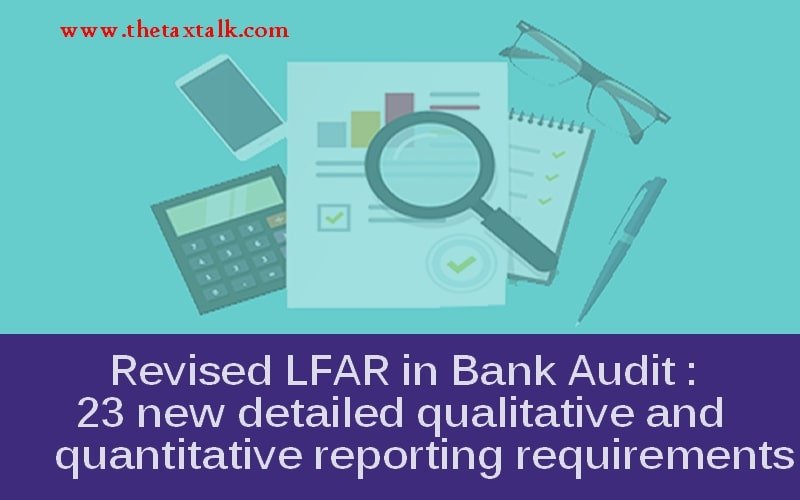![]()
Revised LFAR in Bank Audit : 23 new detailed qualitative and quantitative reporting requirements
No More “YES, NO, N/A” IN revised LFAR
Very detailed workings and documentation have to be carried out to prepare Revised LFAR.
To much of information to be gathered to report on Revised LFAR
RBI is expecting Transaction Audit, the word borrowed from IBC forensic
RBI is expecting ISA audit as a part of statutory branch audit.
RBI is expecting auditor to comment on system driven NPAs and in a same bank various auditors express different conflicting opionions
Broadly, the following are the notable points in revised LFAR:
1) FORENSIC AUDIT Auditors need to go thru account operation transactions in details and comment upon.
2) FORENSIC AUDIT the system and processes of banking supervision on the account operation transactions should be checked and commented upon.
3) ISA AUDIT Verification of data integrity and data related control systems and processes should be carried out and commented upon, with the special thrust on those data inputs which are to be used for MIS at corporate office level and for supervisory reporting purposes.
4) No of accounts verified along with % of accounts verified have to be given in LFAR
5) Auditors have to comment on all those accounts which are quick mortality. i.e. accounts becoming NPA within one year of sanctioning.
6) Auditors have to comment on credit rating system and quantitative details.
7) Auditors to Provide analysis of the accounts overdue for review/renewal and comment on major shortcomings in monitoring,
8) Auditors to comment whether Drawing Power is computed properly.
9) Auditors to comment on status of stock audits and give quantitative data on status of stock audits.
10) Auditors to comment on due diligence reports and give quantitative data on status of Due Diligence reports.
11) Auditors to comment on the substantial deterioration in value of security during financial year as per latest valuation report in comparison with earlier valuation report on record
12) Auditors to comment on deficiencies, including in value of securities and inspection thereof or any other adverse features such as frequent/ unauthorized overdrawing beyond limits, inadequate insurance coverage, etc.,
13) Auditor to comment on early warning systems red-flagged accounts.
14) Auditor to Comment on adverse features considered significant in top 5 standard large advances and which need management’s attention.
15) Auditor to comment on branch identification and classification of advances into standard / substandard / doubtful / loss assets through the computer system, without manual intervention.
16) Auditor to comment on the system of classifying the account into SMA-0, SMA-1, and SMA-2.
17) auditor to comment on List the accounts (with outstanding in excess of Rs. 10.00 crore) which have either been downgraded or upgraded with regard to their classification as Non-Performing.
18) Auditor to comment on system of restructured or rephased accounts during the year and quantitative details of restructured and rephased accounts.
19) Auditor to comment on accounts wherein process under IBC is mandated but not initiated by branch and quantitative details of such accounts.
20) Auditor to give Give Age-wise analysis of decrees obtained and pending execution.
21) Auditor to comment on cases concluded the recoveries have been properly
appropriated against the principal / interest as per the policy of the bank.
22) Auditor to comment on documents verified which are centralised processing system and report on exceptions.
23) Auditor to comment on List of instances where interchangeability between fund based and non-fund-based facilities was allowed subsequent to devolvement of LC / invocation of BG.


